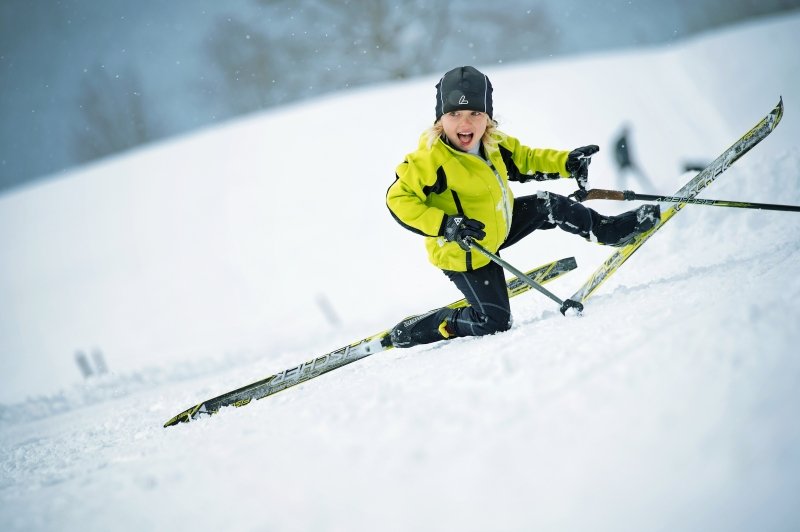So you've decided to try cross country skiing, You can call it cross country skiing, Nordic skiing, XC skiing, or ski touring - when trying cross country skiing the first few times it may be a totally new experience for you and it may take time for you to become confident. Experienced cross country skiers might call you a first timer, beginner, novice skier, and even a "never-ever" but as with any recreational activity, if you do it a few times, it will become easier and more familiar. Cross country skiing can take a while to master, but it is outdoor fun even on the first time on skis.
Downhill Skiing is Not the Same as Cross Country Skiing
Most people believe that if you are an alpine skier and have mastered the lift-served form of snowsports, that you can easily master cross country skiing. But alpine ski equipment is much heavier than cross country ski gear – the big plastic ski boots and wide skis provide substantially more support compared to cross country ski equipment. Snowplowing on cross country skis takes more technique to roll your ankles and hold/push the ski edge of the skis against the snow while you are moving. Even though both sports are on skis and on the snow, there are many differences between downhill skiing and cross country skiing.
Wobbly Feeling
Putting on the comfortable cross country ski boots, stepping on the bindings and attaching to the narrow skis, you may feel a bit wobbly at first. You'll be gliding down the smallest incline and you may feel unsure, but bend your knees and try to relax. Don't lean backwards - bend your knees and feel your weight on your heels and you'll have more control.
You Will Fall Down
Accept that you will likely fall while cross country skiing. Everyone falls while cross country skiing sooner or later and the snow provides a soft landing. Getting up after a fall is sometimes complicated to orchestrate, but take your time to untangle and get to your knees. Once on your knees it should be easy to stand up.
Groomed Trails
Many people dream about cross country skiing as an adventure in the forest and down hills in the wild. The truth is that this form of recreation is much easier on groomed trails…that is, trails that have been packed and tracked by a machine. On groomed trails, it is easier to glide, easier to go up hills, and easier to control the speed going downhill with a snowplow technique. Cross country ski areas provide trail grooming and charge a fee to use the trails. The trail grooming, signage, maps, lodge facilities, and other services are definitely worth the fee. Most cross country ski areas do not allow dogs to use the trails, but some areas offer dog-friendly trails.
To find a cross country ski area, use the Internet or websites such as www.XCSkiResorts.com or the Cross Country Ski Areas Association (www.xcski.org). These areas often require a reservation to get a lesson, as they do not always have instructors on site, so visit an area’s website in advance to get their information.
Be Prepared
The typical safety concerns are prevalent with cross country skiing. Go out with someone else, take water and food, and have some additional clothing (dry gloves, hat, neck gaiter, etc.) in case it gets colder or snows. These concerns can arise if you take a wrong turn where you end up on a longer trail that you expected.
Hills
If the terrain that you are skiing on is perfectly flat, you should not have much problem on cross country skis but when there are hills, you'll encounter the sport's ups and downs. The first time going down a hill could be a bit frightening but as in any sport, with practice you will become more accustomed to the feeling…hopefully. It is best to get tips or a complete lesson. The various cross country ski techniques are taught by experienced or certified instructors at cross country ski areas. Most likely you have friends who try their best to provide insight on ways to master the skis. The former idea (with a certified ski instructor) is the better choice.
Get Out There
Cross country skiing provides one of the greatest full body workouts available as it uses all parts of the body's muscle groups. You may not feel exhaustion while you are out on the trails, but your body is working hard and using unfamiliar muscles, so take it easy. It's best to go on a short outing at first and build up the distance or time on the skis over multiple outings.
Getting information about equipment and the different forms of cross country skiing (on track, off track, skating, backcountry, etc.) can be found on the Internet and/or at a cross country ski area. It makes sense to rent your equipment the first couple of times to see if you like cross country skiing. Most ski areas have rental gear for first timers (skis are softer and wider) and for more athletic people (skis are narrower and more lively). The narrower skis will glide better and go faster, while the wider skis will allow more control but feel like they drag a bit on the flat terrain.
When you get ready to purchase equipment, talk with professionals at a cross country ski area or retail shop to make a decision about what to purchase, which will depend on your interests (on track, off track, control, performance, etc.). Once you become a cross country skier, you'll look forward to when it snows and it will become a magical experience to enjoy every winter. Top photos, Fischer Skis, Bottom photo, Great Glen, NH



